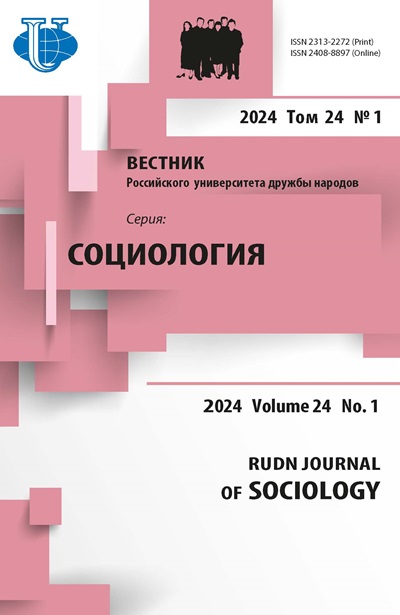Rules of political communication in the pre-war Soviet countryside
- Authors: Merl S1
-
Affiliations:
- Bielefeld University
- Issue: Vol 17, No 2 (2017)
- Pages: 192-201
- Section: Theory, Methodology and History of Sociological Research
- URL: https://journals.rudn.ru/sociology/article/view/15916
- DOI: https://doi.org/10.22363/2313-2272-2017-17-2-192-201
Cite item
Full Text
Abstract
The author aims to debunk the Soviet official myth of local administration as being weak and not functioning effectively. The Soviet regime could not function in the way it pretended to, and the official picture of the economy was far from the reality though played a central role in the political discourse for the aims of legitimacy. The command economy actually functioned as a symbiosis of commands and threats ‘from above’ and corrupt practices of the majority of people including officials. However, this symbiosis worked quite successfully in industry ensuring impressive rates of growth, but not in agriculture and rural areas. Certainly, the kolkhoz system also combined severe control and treats with tolerance to corrupt practices condemned in the official slogans so as to save people from starvation. However, in the countryside the myth that rural administration was weak and wrongdoing proved to be the strongest basis of the regime for it corresponded to the firm conviction of rural people and traditional expectations that Stalin would pursue the paternalist rule as a “good tsar” by punishing local officials (as scapegoats) and by removing them from office (after blaming them for regime’s shortcomings as incompetent managers). To keep people from protests und rebellions the rural officials’ task was not only to use force and intimidation during the campaigns, but also to look away allowing the kolkhozniki from time to time to betray the state as compensation. Thus, the Soviet rural administration fulfilled its functions set by the regime, such as ensuring political communication for the aims of the faith in the legitimacy of the political rule. The author also considers a vertical channel of communication between the people and the regime - petitions to the ruler. Soviet people were encouraged to write letters including complaints to “bargain” personal dissatisfaction. Soviet peasants considered such a communication as a privilege and a part of the paternalist rule. For the regime, the most important function of such letters was preventing local protests by the timely reaction so as not to let the dissatisfaction to reach a critical level. Peasant letters became an additional means of control over rural officials that put limits to their arbitrariness.
About the authors
S Merl
Bielefeld University
Email: smerl@uni-bielefeld.de
University St., 25, 33615, Bielefeld, Germany
References
- Altmann I. Opfer des Hasses. Der Holocaust in der UdSSR 1941-1945. Mit einem Vorwort von Hans-Heinrich Nolte (Zur Kritik der Geschichtsschreibung, Bd. 11). Gleichen/Zürich; 2008.
- Berkhoff K.C. Harvest of Despair. Life and Death in Ukraine under Nazi Rule. Cambridge-L.; 2004.
- Berliner J.S. Factory and Management in the USSR. Cambridge; 1957.
- Die Stalinsche Staatsverfassung von 1936. H. Altrichter (ed.) Die Sowjetunion. Von der Oktoberrevolution bis zu Stalins Tod. Bd. 1: Staat und Partei. München; 1986.
- Dobronozenko G.F. Kulak kak ob’ekt social’noj politiki v 20-e - pervoj polovine 30-ch godov XX veka (na materialach Evropejskogo Severa Rossii) [Kulak as an Object of the Social Policy in the 1920’s - the first half of the 1930’s (on the data from the European North of Russia)]. Saint Petersburg; 2008. (In Russ.).
- Erren L. Stalinist rule and its communication practices: An overview. K. Postoutenko (ed.) Totalitarian Communication, Hierarchies, Codes and Messages. Bielefeld; 2010.
- Filtzer D. Atomization, “molecularization”, and attenuated solidarity: Workers’ responses to state repression under Stalin. B. Studer, H. Haumann (eds.) Stalinistische Subjekte. Individuum und System in der Sowjetunion und der Komintern, 1929-1953. Zürich; 2006.
- Fitzpatrick S. Stalin’s Peasants. Resistance and Survival in the Russian Village after Collectivization. N.Y.; 1994.
- Gregory P. The Political Economy of Stalinism. Evidence from the Secret Soviet Archives. Cambridge; 2004.
- Kindler R. Stalins Nomaden. Herrschaft und Hunger in Kasachstan. Hamburg; 2014.
- Langenohl A. Afterthoughts on “totalitarian” communication. K. Postoutenko (ed.) Totalitarian Communication. Hierarchies, Codes and Messages. Bielefeld; 2010.
- Merl S. Der Agrarmarkt und die Neue Ökonomische Politik. Die Anfänge staatlicher Lenkung der Landwirtschaft in der Sowjetunion 1925-1928. München, Wien; 1981.
- Merl S. Bauern unter Stalin. Die Formierung des sowjetischen Kolchossystems 1930-1941. Berlin; 1990a.
- Merl S. Sozialer Aufstieg im sowjetischen Kolchossystem der 30er Jahre? Über das Schicksal der bäuerlichen Parteimitglieder, Dorfsowjetvorsitzenden, Posteninhaber in Kolchosen, Mechanisatoren und Stachanowleute. Berlin; 1990b.
- Merl S. Die sowjetische Kommandowirtschaft - warum scheiterte sie nicht früher? Geschichte in Wissenschaft und Unterricht, 2007;58:656-677.
- Merl S. Die Korruption in Russland heute - ein Vermächtnis Stalins? C. Söller, T. Wünsch (eds.) Korruption in Ost und West. Eine Debatte. Passau; 2007.
- Merl S. Politische Kommunikation in der Diktatur. Deutschland und die Sowjetunion im Vergleich. Göttingen; 2012.
- Merl S. Kak udalos’ Stalinu vosprepjatstvovat’ “zelenoj revoljucii” v Rossii? K voprosu o tormozhenii agrarno-technicheskogo progressa (1927-1941) [How Stalin managed to stop the “green revolution” in Russia? On the deceleration of agrotechnical progress]. Krest’yanovedenie. Teoriya. Istoriya. Sovremenost‘. Uchenye zapiski 10. Moscow; 2015. (In Russ.).
- State Archive of the Russian Federation (GARF), fond R-5446, opisi 59, 82, 83 and 85. (In Russ.).
- Viola L. The Unknown Gulag. The Lost World of Stalin’s Special Settlements, Oxford; 2007.
- Yaney G. The Urge to Mobilize. Agrarian Reform in Russia 1861-1930. Urbana; 1982.














